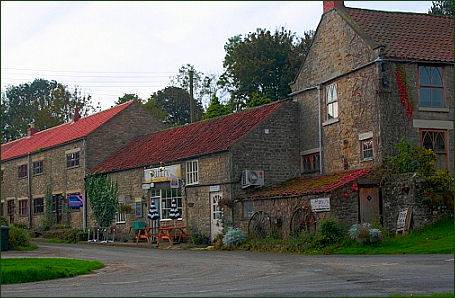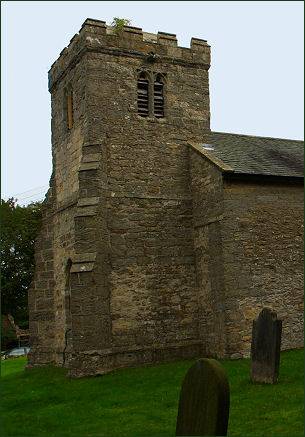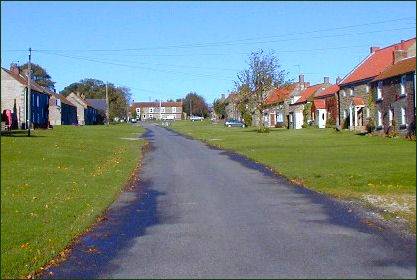Lockton and Levisham
OS grid reference:-
 The pretty village of Lockton (pictured left), on the edge of the North Yorkshire Moors near Pickering, is separated from its equally attractive but larger neighbour, Levisham, (below left) by a deep gorge which Levisham Beck runs through.
The pretty village of Lockton (pictured left), on the edge of the North Yorkshire Moors near Pickering, is separated from its equally attractive but larger neighbour, Levisham, (below left) by a deep gorge which Levisham Beck runs through.
 The spectacular scenery of the area around the villages results partly from geological activity dating back millions of years, partly from human activity over the last ten thousand or so years. There are numerous archaeological sites on Levisham Moor bearing witness to the activities of nomadic people of the Neolithic period followed by farming people from the Bronze Age onwards. Burial mounds and of extensive territorial boundary dykes from these prehistoric times can be seen.
The spectacular scenery of the area around the villages results partly from geological activity dating back millions of years, partly from human activity over the last ten thousand or so years. There are numerous archaeological sites on Levisham Moor bearing witness to the activities of nomadic people of the Neolithic period followed by farming people from the Bronze Age onwards. Burial mounds and of extensive territorial boundary dykes from these prehistoric times can be seen.
Both villages are recorded in the Domesday Book of 1086, where Lockton is referred to as 'Loca's Farm'.
The thirteenth-fourteenth century church of St Giles, (pictured right) in Lockton, is well worth a visit. The building has real charm. It has box pews adapted to the style of the nineteenth century, and an ancient pulpit and reading desk along with matching altar rails. The beautiful stained glass window at the East end depicts Christ the Good Shepherd, and is understood to be from the Morris workshop.
The more recent church of St John the Baptist, built in the nineteenth century, contains a Norman Font and some interesting carved Saxon stones from the abandoned medieval church of Levisham. The Dragon Stone, an early Christian sculptured stone is an Anglo/Danish stone or graveslab and stands in the porch . It dates from around 1000 AD.and has a long flowing dragon carved onto it, as well as a runic inscription and other swirling, interlaced decoration. It is the largest broken portion of the stone; the other fragments stand at the side. The Dragon Stone had originally stood inside the old St Mary's church, but when that fell into ruin the stones were brought to St John's for safety.
 The original Parish Church of St Mary the Virgin, in the valley between Lockton and Levisham, stands at the bottom of the bank south of the village by Levisham Beck near Levisham Mill
Farm and is now a ruin. The chancel still retains a roof but the nave is an empty unroofed shell.
The original Parish Church of St Mary the Virgin, in the valley between Lockton and Levisham, stands at the bottom of the bank south of the village by Levisham Beck near Levisham Mill
Farm and is now a ruin. The chancel still retains a roof but the nave is an empty unroofed shell.
Archaeological and documentary evidence suggests that the first Church on the site was built in the early Norman period, though various pieces of carved stone have been found from Saxon times. The grave slab incised with a sword, which can be seen in the ruins of the chancel) may be that of Ralph de Bolbeck, a thirteenth century lord who had lands at both Lockton and Levisham. He may have built the Church in this spot in order to serve both his manors.
The first written record of a mill at Levisham is dated the year 1246AD 'when Ralph De Bolebeck gave Thomas de Haukesgarth half a mark yearly rent from his mill at Levisham in return for Haukesgarth giving up any other claim to the mill' and it would seem likely that a water mill existed there for some considerable time before that. Whether the present mill has always occupied the site is a matter of conjecture, it is situated almost halfway between Levisham and Lockton at a point where the very steep valley begins to finally widen and perhaps become less wild. The valley is covered in deep forest and is watered by two parallel streams: Levisham Beck and the Mill Race which join together in the garden of the mill and pass under a wooden footbridge a few yards before the beck passes under the road bridge.
The idyllically located Lockton Tea Rooms and Gallery offers a taste of the North Yorkshire Moors with freshly prepared food tempting traditional home baking including a unique selection of afternoon and cream teas accompanied by a refreshing drink. The tea rooms showcase a unique array of art from across Yorkshire both on display and for sale throughout the tearooms and gallery. Plus you'll also find "The Pantry" a small village store selling basic provisions a much-needed facility and village essential.
The popular walk between the two villages is very pleasant. The famous Hole of Horcum, a giant natural amphitheatre carved out of Levisham Moor, makes for a great view en route.The hollow is 400 feet deep and stretches 3/4 of a mile across. A "Devil's Punchbowl" type feature, local legend states that the amphitheatre was formed when Wade the Giant scooped up a handful of earth to throw at his wife during an argument. The ruined folly of Skelton Tower, an important local landmark and a Grade II listed building, was constructed around 1830 as a shooting lodge by the Rev. Robert Skelton, a former rector of Levisham.
Towns and Villages of Yorkshire
